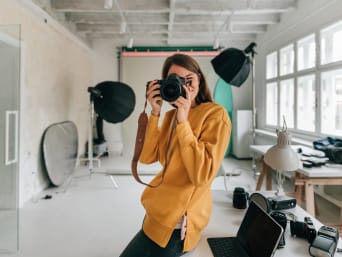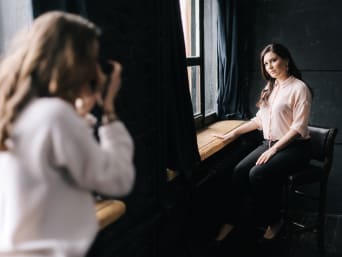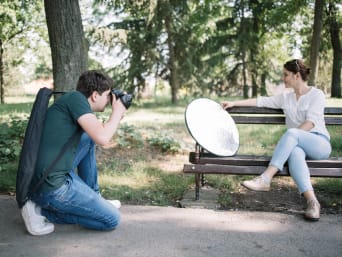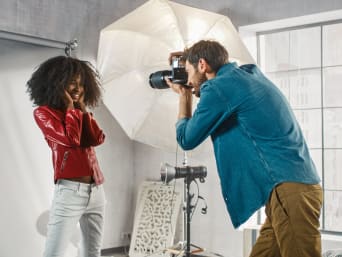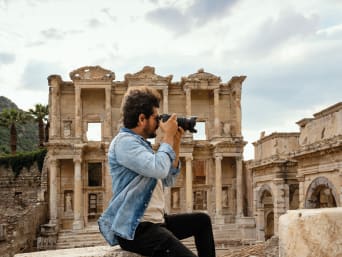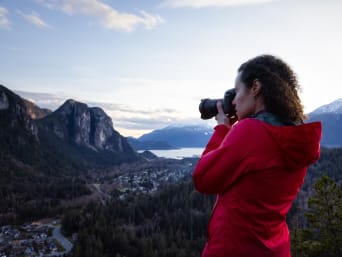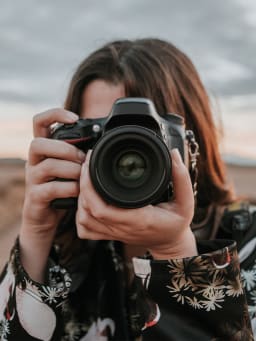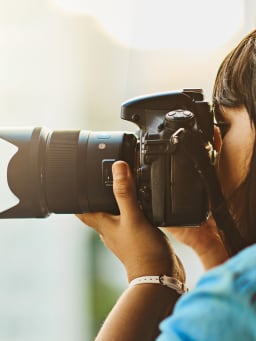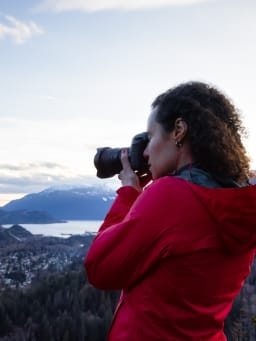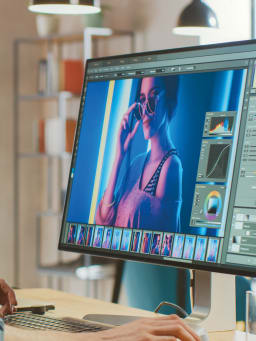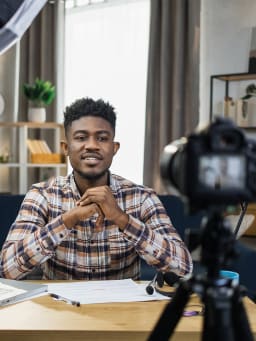Different types of photography: portrait, fashion & architecture photography for beginners
The more you explore the world of photography, the more likely you are to find your favourite type. Some love to highlight the beauty of a landscape in a photo, others find their passion in working with other people or wildlife. To give you an insight into the different types of photography, we will introduce you to portrait, fashion and architectural photography. In addition, we will give you some helpful tips and advice on using the correct camera settings so that you can try out these different types of photography.
Portrait photography for beginners – tips and settings
The art of portrait photography is not only about taking great photos of a person, but it also aims to provide an insight into the soul and personality of a particular person. This is why portrait photographers prefer to get to know their models before taking photos as this helps them to get more authentic looking photos.
In order to get some great portrait photos, you can follow some of the helpful portrait photography tips listed below:
Get to know your model in advance: discuss what your model’s personality is like, what interest do they have and what do they particularly like about themselves. By getting to know your models beforehand will help you to find the perfect motif. It is also important to make sure that your model always feels relaxed as this will make the photos look more authentic.
Perspectives in portrait photography: you have the choice of choosing between frontal, half profile, three-quarter profile and profile. Each perspective looks different on a person, so make sure to try out different ones to get a great photo, that tells a great story.
Working with a highlight: to make a portrait look particularly lively, a point of light should be visible in the eye of the person depicted. Ideally, this point of light should be in the upper area of the eye and it should have a round shape and appear natural.
Only use one guiding light: the most authentic photos are those in which only one primary light source is used. Here you can try out different positions to get the best effect.
Trying different poses: your portrait photo should not look forced, but it should appear natural. To achieve this effect, you can try out different poses or facial expressions and maybe even change the location.
Portrait photography: settings and the right camera accessories for beginners
When trying portrait photography for the first time, you usually don't need any special camera accessories. However, if you enjoy doing this type of photography, you can then get more camera specific accessories. To start off with you can use the following camera settings and accessories for portrait photography:
When you are doing portrait photography, you will need to focus on the model. Therefore, it is recommended to make the background blurry so that the person will stand out in the foreground. You can do this with the following settings:
ISO: 100 to 200 at the beginning, but it is best to take photos in daylight. However, it should not be too sunny or bright so that your model will not be blinded by the light.
Aperture: from 1.4 for a blurred background
Focus: single focus point on your model's eyes
Shutter speed: 1/160s to 1/250s to avoid motion blur
Camera accessories for portrait photography:
Camera: by using a camera for beginners, you can usually take great portrait photos. If you would like to take more professional looking photos later, you can invest in a camera with a larger image sensor that offers you even more possibilities in terms of depth of field.
Lens: it is best to use a fixed focal length lens for portraits, as these are faster, and the depth of field can be managed better. For a realistic image effect, lenses with a focal length between 50 and 100 mm are recommended.
Other camera accessories: using a folding reflector, you can discreetly illuminate your model without using another light source. You can also bring props and a change of clothes for your model.

The link between ISO, aperture and shutter speed ensures that your photos are correctly exposed and that you can take advantage of your creative skills such as motion blur, depth of field, etc. In the following article we will explain how to use these three important elements - "The basics of photography".
An insight into fashion photography: tips & settings explained for beginners
Fashion photography is the perfect mix of product and portrait photography from an artistic perspective. Here, both individual items of clothing and entire outfits need to be well presented so that they don’t appear boring. Fashion photography is all about telling a story about a particular item of clothing or outfit in a creative way.
The fashion photography tips below will help you get started and they will also convey a dynamic and positive attitude to life:
Practicing with friends: a very relaxed photo shoot allows you to gain confidence and an insight into fashion photography. Go through your wardrobe with friends and pick out your favourite clothes. Afterwards, you can try and do a fashion photo shoot with your friends. It is also a good idea to try modelling yourself to learn more about the different perspectives.
Start in daylight: make sure to plan your first photo shoot during the day. This will help you to learn more about the effect of natural light and how to work with it. Afterwards you can try and do a photo shoot in a photo studio. However, when getting started it is recommended to only work with one light source and some reflectors if needed.
Plan your photo shoots: always make sure to plan your photo shoots in advance. Beforehand it is a good idea to create a mood board or look for some inspiration online. By doing so you will know which photos you would like to take, which will make it easier for you to guide your model.
Photo shoots which don’t seemed forced: will make your pictures look fantastic. Make sure that your models feel comfortable as this will give the photos a much more authentic look.
Try different things out to tell a great story: by trying different perspectives for your fashion photos, you can find new angles. It is also worthwhile combining different items of clothing together to get some great shots.
Fashion photography tips for beginners on getting the right camera settings & accessories
You don’t need a lot of camera accessories for taking your first fashion photography photos in daylight. The settings and camera accessories below will help you to get started:
The focus of your photo should be on the model or the clothes. It is recommended to use the following camera settings below for your first fashion shoot:
ISO: 100 to 200 (in daylight)
Aperture: from 1.4 for a blurred background and from 4 for a detailed background.
Focus: for moving subjects use autofocus, use single focus point with stationary subjects.
Shutter speed: 1/160s to 1/250s to freeze the movement.
Camera accessories for fashion photography:
Lens: to capture both the whole outfit and only certain details of the clothes a zoom lens with a focal length of 24-70 mm is recommended. However, a fast fixed focal length lens of 50 mm can also work well.
Other camera accessories: a folding reflector is also recommended to make small shadows disappear. Camera clips can ensure that the clothes have a good fit on the model. It is also recommended to have an iron at the photo studio to make sure that the clothes are crease-free.

The right light can make your pictures look more dynamic. Therefore, make sure that you do not shine direct light onto your model from the front. Try and make the light appear as though it is shining from the side of the picture. This will make it look more vibrant.
Architectural photography: tips & camera settings for beginners
Take your camera with you and take some great shots of buildings and tell your own photography story. Architectural photography covers all areas of architecture from old castles to modern skyscrapers, bridges and entire cityscapes. This type of photography also covers interiors of buildings. The biggest challenge here is to take photos of buildings, but to make sure their features and highlights really stand out. This is especially important with older buildings as this helps to tell their story.
The tips below are for beginners which will help you to take breath-taking architectural photos:
Getting to know your subject: stary off by taking a closer look at the building from each side and try to discover small details that you want to emphasise later in your photos. It is can also be interesting to find out more about the history of the building to get a new perspective.
Avoid plunging lines: whilst taking photos of large buildings from the central perspective they can appear to be tilting backwards. To avoid plunging lines make sure that the image sensor is parallel to the building. This can be done by leaving more distance between you and your subject or by raising your point of view.
Using symmetries and patterns: architectural photography is all about symmetry. Therefore, it is always a good idea to incorporate symmetries into your image. Reflections or interesting patterns such as tiles, wallpaper, etc. can make your photos really stand out.
Photograph details: certain features on some buildings are sometimes more exciting than the building itself. Therefore, try and capture the features in parts of your pictures.
Use leading lines: railings, columns or paths can lead into your picture and thus draw the viewer's attention to the subject.

If you are taking some photos in a city, you can make people disappear by selecting a long exposure time. This way, people walking by won’t be as visible. When doing this it is best to use a tripod.
Architectural photography camera settings & accessories needed for your first photo shoot
You don't have to travel far to take interesting photos of buildings. There will be some interesting looking buildings in your local area that you can rediscover with a camera. All you will need is your camera and a few additional camera accessories:
The building should be clearly visible in your photo so that you can see the fine details of it. The recommended settings below will help you to take detailed architectural photos:
ISO: 100 to 200 (in daylight)
Aperture: from 8 for a greater depth of field
Shutter speed: only several seconds to achieve the highest possible depth of field.
Camera accessories needed for architecture photography
Lens: any type of lens can be used for architecture photography. By using a zoom lens, you can highlight interesting details, whereas a fixed focal length lens makes it easier to take photos at night and a wide-angle lens can capture large areas.
Other camera accessories: for a long exposure you will need a small compact tripod that you can easily set up and put away. In addition, an ND filter can help you to set long exposure times even in daylight.
Landscape and wildlife photography are also very interesting. In this article we will show you both types of photography and give you some tips on which camera settings and accessories are useful for beginners.
Conclusion: portrait, fashion and architectural photography are ideal for beginners
Each type of photography has its own unique style and challenges. If you are still not sure which one is best suited to you then why not have a go at the different types of photography and gain experience at the same time. You can also get creative by trying out different photo genres and camera settings, which will help you to find the perfect mix.
______________________________________________
References
https://www.adobe.com/creativecloud/photography/discover/fashion-photography.html
(last accessed on 26.10.2022)
https://www.arch2o.com/tips-architecture-photography-beginners/
(last accessed on 26.10.2022)
https://www.artinstitutes.edu/about/blog/38780-v2-7-types-of-photography-styles-to-master
(last accessed on 26.10.2022)
https://www.masterclass.com/articles/portrait-photography-tips
(last accessed on 26.10.2022)
Image sources
iStock.com/AleksandarNakic
iStock.com/dikushin
iStock.com/Synergicworks
iStock.com/gorodenkoff
iStock.com/ozgurdonmaz
iStock.com/edb3_16
